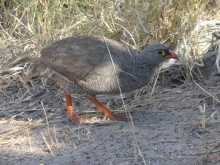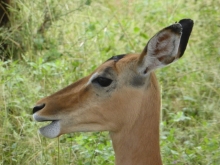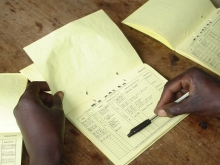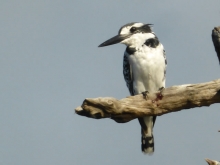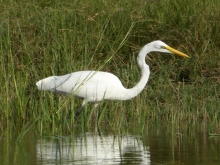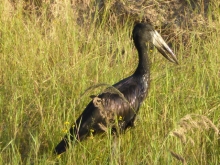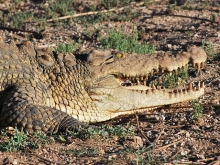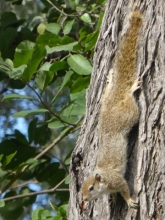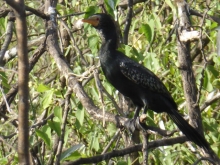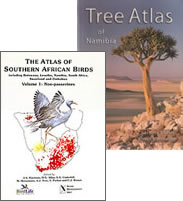Fauna
Birds
Over 420 species of birds have been recorded from the Mudumu Landscape, making it one of the most bird-rich areas of Namibia. Many wetland species here are not found anywhere else in Namibia.
Mammals
Rare and endangered mammals found in the area include wetland species not common elsewhere in Namibia such as reedbuck, waterbuck, lechwe, puku, roan, sable, tsessebe, buffalo, wild dog, hippo and elephant.
Reptiles
The landscape is home to a range of reptiles, especially snakes, and substantial numbers of crocodiles.
Amphibians
As a consequence of the diversity of wetland habitats, the Mudumu Landscape supports a wealth of amphibians including the endemic Mpacha Grass Frog.
Relevant literature
-
Aerial Wildlife Census of the Caprivi River Systems - a survey of water bodies and floodplains 11 - 20 August 2004
Stander, P. 2004. Aerial Wildlife Census of the Caprivi River Systems - a survey of water bodies and floodplains 11 - 20 August 2004
An aerial wildlife census of the Caprivi River Systems in Namibia was conducted between 11 and 20 August 2004. A total count of water bodies and floodplains of the Kavango, Kwandu, Linyanti, Chobe and Zambezi was done to asses the numbers of hippopotamuses, floodplain ungulates, crocodiles, and some large birds. Counting areas were divided into 15km2 blocks and, with the use of GPS and mobile GIS technology, each block was covered intensively.» Download -
Analysis of Historic Fisheries Research Data for the Caprivi Region, April 2009
Hay, C.J. and van der Waal, B.C.W. 2009. Analysis of Historic Fisheries Research Data for the Caprivi Region, April 2009. Integrated Management of Zambezi/Chobe River System - Tansboundary Fishery Resource, Namibia/Zambi/Botswana. Technical Report no. MFMR/NNF/WWF/Phase I/2
This is a summary report taken from the reference document that was prepared for the Namibia Nature Foundation. The study was commissioned to analyze all available data collected since 1997. The objectives of the report are spelled out in this document. This summary document highlights the important findings.» Download -
Bwabwata National Park - People and wildlife - a shared history
Bwabwata National Park - People and wildlife - a shared history
Bwabwata has been inhabited for millennia, but it is the more recent history that has shaped the Bwabwata National Park of today. Proclaimed in the 1960s as the Caprivi Nature Reserve, then as the Caprivi Game Park, no initial wildlife management took place because the area was a restricted security zone, occupied first by the South African police and subsequently by the South African Defence Force (SADF).» Download -
Caprivi and Bwabwata Game Count poster 2011
Caprivi Game Count poster 2011
Game counts in Bwabwata and Caprivi; dry season, live sightings. showing Numbers seen by conservation area, habitat, compared to 2010, population estimates and trends» Download -
Caprivi and Bwabwata Game Count poster 2012
Caprivi and Bwabwata Game Count poster 2012
Game counts in Bwabwata and Caprivi; dry season, live sightings. showing Numbers seen by conservation area, habitat, compared to 2011, population estimates and trends» Download -
Caprivi and Bwabwata Game Count poster 2013
Caprivi and Bwabwata Game Count poster 2013
Game counts in Bwabwata and Caprivi; dry season, live sightings. showing Numbers seen by conservation area, habitat, compared to 2012, population estimates and trends» Download -
Caprivi crocodile research project
Aust, P. 2007. Caprivi crocodile research project
This report contains information on aspects of the ecology, conservation and management of crocodiles in North Eastern Namibia. It is intended to give an overview of the research work carried out by the Caprivi Crocodile Research Project over the last two years (2006/2007).» Download -
Caprivi Elephant Monitoring Project. Final Report
Rodwell, T.C. 1995. Caprivi Elephant Monitoring Project. Final Report (October 1992 to October 1995)
» Download -
Caprivi Game Count poster 2011: conservancies only
Caprivi Game Count poster 2011: conservancies only
Game counts in Bwabwata and Caprivi (conservancies only); dry season, live sightings. showing Numbers seen by conservation area, habitat, compared to 2010, population estimates and trends» Download -
Caprivi Game Count poster 2011: protected areas only
Caprivi Game Count poster 2011: protected areas only
Game counts in Bwabwata and Caprivi (protected areas only); dry season, live sightings. showing Numbers seen by conservation area, habitat, compared to 2010, population estimates and trends» Download -
Economic Analysis of Land Use Policies for Livestock, Wildlife and Disease Management in Caprivi, Namibia, with Potential Wider Implications for Regional Transfrontier Conservation Areas
Barnes, J.I. 2013. Economic Analysis of Land Use Policies for Livestock, Wildlife and Disease Management in Caprivi, Namibia, with Potential Wider Implications for Regional Transfrontier Conservation Areas. Technical Report to the Wildlife Conservation Society’s AHEAD Program and the World Wildlife Fund
Standard cost-benefit analysis was applied to several future policy options for land use and animal disease management in Caprivi, Namibia. Emphasis was placed on the livestock-wildlife interface and Caprivi's role as central to the Kavango Zambezi (KAZA) transfrontier conservation area (TFCA). Empirically-based enterprise models measuring private and economic values for livestock and wildlife sectors in Caprivi were used to measure returns to investment for policy options regarding animal disease management and land use allocation. Options included commodity-based trade (CBT) and veterinary control fencing approaches to animal disease management. CBT is a production and marketing approach, which assures product safety regardless of the disease status of the area of origin and therefore permits adaptation of conventional (geographically-based) animal disease control measures. The basic measure of economic efficiency was incremental change in net national income at opportunity cost. Local livelihood contributions were also measured.» Download -
Economic impacts of Transfrontier Conservation Areas: Baseline of tourism in the Kavango-Zambesi TFCA
Suich, H., Busch, J. and Barbancho, N. 2005. Economic impacts of Transfrontier Conservation Areas: Baseline of tourism in the Kavango-Zambesi TFCA. Conservation International South Africa, Paper No. 4
The Kavango–Zambezi Transfrontier Conservation Area (KAZA TFCA) is a multi-objective initiative involving parts of Angola, Botswana, Namibia, Zambia and Zimbabwe. The concept of major tourism destination based on the extensive network of protected areas and wildlife populations has been discussed and developed over the last decade. Recently, the idea has been revitalised by the ministers of those five countries, who seek to establish a world-class transfrontier conservation area and tourism destination in the Okavango and Zambezi river basin regions of those countries, within the context of sustainable development.» Download -
Elephant Distribution and Abundance in the Caprivi Strip: Results of an Aerial Survey in 2003
Griffin, C.R. and Chase, M.J. 2004. Elephant Distribution and Abundance in the Caprivi Strip: Results of an Aerial Survey in 2003. Conservation International. Final Report, January 23, 2004. Submitted to Ministry of Environment and Tourism
» Download -
Elephant Distribution and Abundance in the Lower Kwando River Basin and West Caprivi
Chase, M.J. and Griffin, C.R. 2006. Elephant Distribution and Abundance in the Lower Kwando River Basin and West Caprivi
During October and November 2005, we conducted aerial surveys over the Lower Kwando River Basin (LKRB) and the West Caprivi to determine elephant distribution and abundance. This region offers the best potential for restoring elephant and other wildlife populations into the conservation areas of southeast Angola and southwest Zambia.» Download -
Fish and livelihoods: Fisheries on the eastern floodplains, Caprivi
Purvis, J. 2002. Fish and livelihoods: Fisheries on the eastern floodplains, Caprivi. Research Discussion Paper No 52, Directorate of Environmental Affairs, Ministry of Environment and Tourism, Namibia
The paper outlines the production system on the eastern floodplains in the Caprivi paying special attention to the fishing activities. Although there are already some indications that the resource may be overfished, this paper suggests that the situation could become much worse if the current trends continue - continued weakening of the influence of the traditional management systems; increasing availability of fishing inputs; market demand and prices for fish remain strong; and worsening problems in the agricultural sector (e.g. withdrawal of government subsidies for certain inputs, increasing incidence of wildlife/human conflicts, marketing problems). This paper calls for, among other things, further work to investigate the options and feasibility of developing some type of co-management regime (involving fisherfolk, government and other stakeholders in the management of the fishery) to ensure that the fishery is managed sustainably and continues to play an important role in the floodplain livelihood system.» Download -
Fish populations, gill net catches and gill net selectivity in the Kwando River, Namibia
Næsje, T.F., Hay, C.J., Nickanor, N., Koekemoer, J.H., Strand, R., and Thorstad, E.B. 2004. Fish populations, gill net catches and gill net selectivity in the Kwando River, Namibia. - NINA Project Report 27. 64pp.
The objective of this report is to provide baseline information about the fish resources in the Namibian part of the Kwando River to form the biological foundation for recommendations for a sustainable management of the fish resources. Based on fish survey data from the period 1997-1999, the fish resources are described through studies of species diversity, relative importance of the different species, life history parameters, catch per unit effort and gill net selectivity.» Download -
Fish Ranching Programme in Caprivi Region
Murphy, C. and Lilungwe, P. 2012. Fish Ranching Programme in Caprivi Region. Integrated co-management of the Zambezi/Chobe River Fisheries Resources Project. Technical Report no. MFMR/NNF/WWF/Phase II/5
The Caprivi Region is well supplied with natural pans and ponds and has numerous old "borrow pits" left from past road construction activities. This makes the Region suited to fish ranching that uses ponds stocked with fingerling to grow larger fish. Such ponds can be either ephemeral, where fish need to be stocked annually and harvested a few months later when the ponds start to dry out, or semi-permanent, where stocking can be less frequent provided naturally produced fingerlings are left in the ponds when harvesting of the larger fish takes place. From 2007, NGOs assisted local people to develop fish ranching activities at 30 sites in Caprivi. This is the only project of this nature in Namibia and has the distinct advantage over fish farming is that inputs are very low (mainly labour to clear ponds of unwanted plants and fish species, feeding with any garden or food waste and harvesting). The existing fish ranching initiative is viable. Annual records from half of the existing ponds show that the commercial value of fish harvested would be about a quarter of a million Namibian Dollars, if the fish had been sold at the Katima Market. As most of the harvest from the fish ranching was consumed locally, this is an amount that people potentially saved in not having to buy food to eat. As Mr Tsukhani from Machita said, "If the fish ranching project continues, our sons will eat". An estimated sales figure from the actual fish sold at all the fish ranching sites in one year was about N$ 40 000. Some of this fish sales income was reinvested in the fish ranching business through the purchase of fishing equipment (e.g. hooks were bought at Lyanzoka) or fish food (e.g. bran at Machita). Other income was invested in education. At Machita village, the fish pond committee opened a Nampost account with the N$ 1 500 they earned from selling big fish and also fingerlings to a neighbour. Most of this fish ranching income (N$ 1 000) was spent on school funds and uniforms for 22 orphans. The price for fish in Caprivi is high (N$ 10/kg at source or N$ 20/kg Katima Market) and market forces have the potential to provide the incentive for continued management of fish ranching at the community level.» Download -
Flora, fauna and conservation of East Caprivi wetlands
Schlettwein, C.H.G., Simmons, R.E., Macdonals, A. and Grobler, H.J.W. 1991. Flora, fauna and conservation of East Caprivi wetlands. Madoqua, 17(2): 67-76
The largest natural permanent surface waters in Namibia occur in the wetlands of East Caprivi and are fed by two of Namibia's five perennial rivers.» Download -
Game counts in Bwabwata and Caprivi 2010
Game counts in Bwabwata and Caprivi 2010
Game counts in Bwabwata and Caprivi; dry season, live sightings. showing Numbers seen by conservation area, habitat, compared to 2009, population estimates and trends.» Download -
Game counts in Bwabwata and Caprivi 2010: conservancies only
Game counts in Bwabwata and Caprivi 2010: conservancies only
Game counts in Bwabwata and Caprivi (conservancies only); dry season, live sightings. showing Numbers seen by conservation area, habitat, compared to 2009, population estimates and trends.» Download -
Game counts in Bwabwata and Caprivi: map of live sightings
Game counts in Bwabwata and Caprivi: map of live sightings
Maps showing live sightings of elephant, giraffe, kudu, roan, sable, buffalo, impala, reedbuck, tsessebe and zebra in the 2010 Caprivi game count» Download -
Lake Liambezi, Namibia: fishing community assumes management responsibility, July 2011
Tweddle, D., Weyl, O.L.F., Hay, C.J., Peel, R.A. and Shapumba, N. 2011. Lake Liambezi, Namibia: fishing community assumes management responsibility, July 2011. Integrated co-management of the Zambezi/Chobe River Fisheries Resources Project. Technical Report no. MFMR/NNF/WWF/Phase II/4
The Caprivi Region in Namibia is a narrow strip of land extending eastwards from the northeastern corner of the country, and is bordered by Angola and Zambia to the north, Botswana to the south and Zimbabwe to the east. The region is flat and characterised by numerous swamps and slow-flowing rivers. A major swamp system is centred on Lake Liambezi. This lake receives water from several sources. To the west, the Kwando River originates in the Angolan Highlands and forms the boundary between Angola and Zambia. Passing through the Caprivi Strip, the Kwando then percolates through the Linyanti swamps on the Namibia-Botswana border before feeding into Lake Liambezi. Rainfall and run-off from the area to the north of the lake also feed the lake. Floodwaters from the Zambezi enter the lake from the east during high flood years from two directions. The Chobe River reverses flow direction annually when the Zambezi floods and enters the lake from the southeast, while the Bukalo channel enters the northeast of the lake from the Caprivi floodplain. Outflow from the lake via the Chobe River when floodwaters recede is intermittent and dependent on lake level.» Download -
Living with wildlife – the story of Mudumu North Complex
Living with wildlife – the story of Mudumu North Complex. NACSO. 20 pp.
Profile booklet providing information on Mudumu North Complex with sections on resources and attractions, livelihoods and development, managing natural resources, Kwandu conservancy, Mashi conservancy, Mayuni conservancy, Sobbe conservancy, community forestry, the Kyaramacan association, the national parks, challenges, opportunities and the future.» Download -
Mudumu North Complex: Wildlife Co-Management in the Kwando Area of the Caprivi
Martin, R.B. 2006. The Mudumu North Complex: Wildlife Co-Management in the Kwando Area of the Caprivi. A Study for the Ministry of Environment and Tourism and the Management Committee of the Mudumu North Complex
» Download -
Postharvest fisheries on the eastern floodplains, Caprivi
Purvis, J. 2002. Postharvest fisheries on the eastern floodplains, Caprivi. Research Discussion Paper No 51, Directorate of Environmental Affairs, Ministry of Environment and Tourism, Namibia
With concerns regarding over-fishing in the Caprivi Region, the search for improvements in the fishery sector may lie in closer examination of the post-harvest sector. Opportunities need to be sought that emphasise maximising the benefits obtained from fish already caught. Improving the efficiency of post-harvest handling, processing and marketing can significantly improve the livelihoods of producers and traders. This paper describes the post-harvest marketing and distribution systems of fish on the eastern floodplains of the Caprivi region. A number of possible intervention points in the post-harvest chain are suggested, described and potential strengths and weaknesses of these interventions identified.» Download -
Profits, equity, growth and sustainability - The potential role of wildlife enterprises in Caprivi and other communal areas of Namibia
Ashley, C., Barnes, J. and Healy, T. 1994. Profits, equity, growth and sustainability - The potential role of wildlife enterprises in Caprivi and other communal areas of Namibia. Research Discussion Paper No 02, Directorate of Environmental Affairs, Ministry of Environment and Tourism, Namibia
Namibia is endowed with valuable wildlife resources. It already earns some economic benefit from them, mainly through tourism which is one of the fastest growing industries in Namibiarnand worldwide. However, at present, these earnings are below potential, particularly in communal areas where economic incentives for sustainable management have been stifled. As a result, the bulk of economic benefits of wildlife accrue to private enterprise and the government, with residents of communal areas largely excluded. Emerging economic data and comparisons with data from Botswana indicate that wildlife utilisation does have potential to address economic priorities in Namibia: it could provide significant economic and financial returns in communal areas such as Caprivi. With improved legal rights and skills for communities to manage and earn income from wildlife, it could be a valuable and significant complement to livestock keeping.» Download -
Results of a Crocodile Crocodylus niloticus survey in the river systems of north-east Namibia during August 2004
Brown, C.J., Stander, P., Meyer-Rust, R. and Mayes, S. 2004. Results of a Crocodile Crocodylus niloticus survey in the river systems of north-east Namibia during August 2004
This study has provided baseline data on crocodile numbers from aerial and spotlight counts. These data can be used with the results of future counts to determine population trends. The census has also provided information on their distribution of crocodiles in the Kavango and Caprivi regions. And third, it has resulted in the first population estimate for crocodiles in the north-east wetlands of Namibia.» Download -
Species management plan - Southern Reedbuck (Redunca arundinum arundinum), Common Waterbuck (Kobus ellipsiprymnus ellipsiprymnus), Red Lechwe (Kobus leche leche), Puku (Kobus vardoni)
MET 2003. Species management plan - Southern Reedbuck (Redunca arundinum arundinum), Common Waterbuck (Kobus ellipsiprymnus ellipsiprymnus), Red Lechwe (Kobus leche leche), Puku (Kobus vardoni)
The wetland grazer populations in the Caprivi have fluctuated over the past century from being relatively abundant to being near extinction. The fluctuations appear to be linked to long term rainfall cycles. Being on the fringe of larger populations in Botswana, they have usually been able to recover from low levels when the rainfall regime is favourable. Today, the population levels of all four species are a matter for concern: puku are almost extinct; waterbuck have been seen sporadically on surveys but, since 1994, there are no records exceeding 20 animals; lechwe have slumped from nearly 13,000 in 1980 to fewer than 200 now; and reedbuck numbers are about 200 at best.» Download -
Species management plan - Southern Savanna Buffalo (Syncerus caffer caffer)
MET 2002. Species management plan - Southern Savanna Buffalo (Syncerus caffer caffer)
Although not threatened at present, the Namibian buffalo population is well below the level at which it should exist. There is a potential range of some 10,000km2 available for buffalo in the Caprivi and this should carry at least 15,000 buffalo. Because of the high value of buffalo in the international safari hunting industry, the potential net income from wildlife in the Caprivi could be raised from its present level of US$2.5 million to US$7.5 million if the buffalo population was at carrying capacity.» Download -
Spotted hyaena ecology and human-wildlife conflict in the Caprivi Region of Namibia
Hanssen, L. 2011. Spotted hyaena ecology and human-wildlife conflict in the Caprivi Region of Namibia. 2011 Research Report
» Download -
Status of Wattled Cranes on the floodplains of north-east Namibia: results from an aerial survey during August 2004
Brown, C.J., Stander, P., Mayes, S., Conradie, L., Haredoeb, P., Singwangwa, M. and Cilliers, W. 2004. Status of Wattled Cranes on the floodplains of north-east Namibia: results from an aerial survey during August 2004
Areas surveyed: The Okavango River in Namibia, from just northwest the bridge on the Trans-Caprivi highway south to the Botswana border; the entire length of the Kwandu-Linyanti-Lake Liambezi-Chobe system, including the Mamili National Park; and the Zambezi river for its entire length on Namibia’s border, including parts of the adjacent East Caprivi floodplains.» Download -
Status of Wattled Cranes on the floodplains of north-east Namibia: results from an aerial survey during September 2007
Brown, C. Chase, M., Nkala, T., Landen, K. and Aust, P. 2007. Status of Wattled Cranes on the floodplains of north-east Namibia: results from an aerial survey during September 2007
The Okavango River in Namibia, from the Angolan border just northwest of the bridge on the Trans-Caprivi highway south to the Botswana border; the entire length of the Kwandu-Linyanti-Lake Liambezi-Chobe system, including the whole Mamili National Park; and the Zambezi River for its entire length on Namibia’s border, including parts of the adjacent East Caprivi floodplains, were survey from the air in September 2007.» Download -
The conflict continues: Human wildlife conflict and livelihoods in Caprivi
Mulonga, S., Suich, H. and Murphy, C. 2003. The conflict continues: Human wildlife conflict and livelihoods in Caprivi. Research Discussion Paper No 59, Directorate of Environmental Affairs, Ministry of Environment and Tourism, Namibia
The Caprivi Region is one region in Namibia where the community-based natural resource management (CBNRM) programme has achieved considerable success, in terms of capacity building and natural resource management. However, the conflict between people and wildlife is perceived by local residents to have worsened since the advent of the CBNRM programme. This paper forms part of the WILD Project research, which is a Ministry of Environment and Tourism (MET) participatory research project investigating the change that the Namibian CBNRM programme has brought to people\'s livelihoods.» Download -
Wildlife census of Namibia's North East Rivers - 2009
Wildlife census of Namibia's North East Rivers - 2009
The third aerial wildlife census of the Caprivi and Kavango river systems in Namibia took place during September 2009. These surveys cover the Kavango, Kwando, Linyanti, Chobe and Zambezi Rivers and their associated wetlands and floodplains. The area (~18,000 km2) is surrounded by Angola, Botswana, Zambia and Zimbabwe, lying between the Okavango River in the west, and the Zambezi and Chobe Rivers in the east. The Okavango, Kwando, Linyanti and Zambezi rivers provide perennial water.» Download -
Wildlife resources in the Caprivi, Namibia. The Results of an Aerial Census in 1994 and Comparisons with Past Surveys
Rodwell, T.C., Tagg. J. and Grobler. M. 1995. Wildlife resources in the Caprivi, Namibia. The Results of an Aerial Census in 1994 and Comparisons with Past Surveys. Research Discussion Paper No 9, Directorate of Environmental Affairs, Ministry of Environment and Tourism, Namibia
Protected and proclaimed areas in the Caprivi, Namibia, hold most of the economically valuable wildlife species in that region. This wildlife is presently being viewed as a potential resource base to support the many community-based conservation and development programmes in the Caprivi.» Download -
Winter counts of wetland and floodplain birds in the Kwando River and floodplain system, Caprivi
Brown, C.J and Meyer-Rust, R. 2004. Winter counts of wetland and floodplain birds in the Kwando River and floodplain system, Caprivi
Human and, increasingly, elephant pressure on Namibia’s wetlands and riparian belts are a major cause of conservation concern. Many wetland birds are listed in Namibia’s Red Data Book (Simmons & Brown in prep) because of population declines caused by the degradation and destruction of wetland habitats, and because of high levels of disturbance. Good information on the status of major wetlands and their avifauna is important for their conservation management. Birds provide one of the best indicators of wetland health. That is why wetland bird counts are such an important part of Namibia’s environmental monitoring system.» Download


